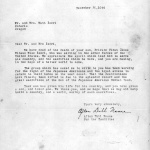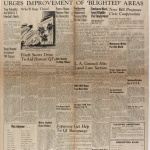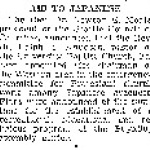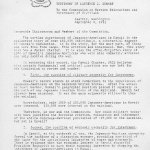John Burns
| Name | John Anthony Burns |
|---|---|
| Born | 1909 |
| Died | April 5 1975 |
| Birth Location | Fort Assiniboine, MT |
Governor of Hawai'i, 1962-74. John Anthony Burns (1909–1975) dominated Hawai'i's post-World War II politics by forging a coalition of retuning Japanese American veterans and the membership of the International Longshoremen's and Warehousemen's Union (ILWU) in the Democratic Party. As the territorial party chairman, Burns helped recruit candidates who won control of the Territorial Legislature for the Democrats in 1954. As a political candidate, Burns lost races in 1946, 1948, and 1954. In 1956, however, he became the first Democratic delegate to Congress since the Depression. Although he lost the 1959 state gubernatorial election to Republican William Quinn, Burns won by an overwhelming margin of victory three years later in 1962 and was reelected to two more terms. [1]
Early Life
Burns was born into a military family at Fort Assiniboine, Montana, in 1909. The family followed Sergeant Major Harry Burns to Hawai'i in 1913, only to be deserted by him shortly after he was discharged from the U.S. Army for stealing funds. From 1918, Burns and his three siblings were raised by his mother Anne Florida Burns, who gave her firstborn the religious foundation of his life. However, young Jack Burns was an indifferent student who frequently challenged the authority of St. Louis School. Eventually Burns was sent to Kansas to live with his uncle for two years. After dropping out of school and serving in the U.S. Army for a year, Burns returned to Hawai'i, where he graduated from St. Louis School at the age of twenty-one. Burns enrolled in the University of Hawai'i at Mānoa, but within a year married an army nurse, Beatrice (Bea) Van Vleet and 1931 and dropped out of school. With the start of the Great Depression, Burns took a number of jobs and moved from Hawai'i to California and back.
In 1934, when Burns was twenty-five years old, he began his career as an officer in the Honolulu Police Department. However, on October 7, 1935, Bea Burns, seven months pregnant, was stricken with polio. Bea lost her third child and would be paralyzed and unable to use her legs for the rest of her life. As Bea tried to mitigate the paralysis, on December 14, 1935, the day after she returned home from the hospital, Burns was involved in an automobile accident amid reports that he had been drinking. At this crucial point in his life, his mother stepped forward and gave her son a large dose of "tough love" which changed his life.
Early Career and Political Aspirations
During World War II, Burns received an assignment that reshaped his destiny. In early 1941, Burns was made the head of the Honolulu Police Department's Espionage Bureau to assess the loyalty of the Japanese population in Hawai'i which constituted 37 percent of the population. Through this assignment, Burns came to know the Japanese community and key individuals who later joined the Democratic Party.
By the end of World War II, Burns left the police department to become a politician to begin a revolution to put an end to privilege and to give every citizen an equal opportunity. Achieving his "impossible dream" did not come quickly or easily. [2] It would be nine years before " The Revolution of 1954 " would take place in Hawai'i and eleven years before John Burns would win his first elective office. According to historians Dan Boylan and T. Michael Holmes, during this time, Burns built his political success on four pillars: the Democratic Party; the Japanese American war veterans; organized labor; and his religious faith which had been created from his personal tragedies. [3]
Political Success and Legacy
Twice elected as Hawai'i's delegate to Congress, Burns lobbied for Hawai'i statehood that was achieved on March 12, 1959, when President Dwight D. Eisenhower signed the statehood bill. He ran to become the first governor of the State of Hawai'i but lost the election to Territorial Governor William F. Quinn. Three years later in 1962, Burns won the election and became governor. As governor, Burns played a leading role in stimulating the state economy and attracting foreign tourism and investment. He promoted Hawai'i as a center for oceanography and oversaw the construction of the new state capitol building, Honolulu Stadium, and Interstate H-3. He spearheaded the expansion of Honolulu International Airport and transformed the University of Hawai'i, turning it into a first-class university by attracting students and faculty from all over the world.
Burns was re-elected in 1966 and 1970, with a different lieutenant governor as his running mate each time. However, in 1973, Burns was stricken with cancer and George Ariyoshi , Burns' third elected lieutenant governor became acting governor for the remainder of Burns' third term. He died of cancer on April 5, 1975, just six days after his sixty-sixth birthday, bringing an end to what some historians have called "The Burns Years" in Hawai'i's history. Thousands gathered at the National Memorial Cemetery of the Pacific at Punchbowl to pay their respects. [4] In an emotional eulogy, Ariyoshi, the nation's first Asian American governor, told the mourners that he had "lost another father." [5] Ariyoshi focused upon his mentor's unselfish approach to the challenges he had faced stating, "In all his work, he sought no personal recognition. He wanted all of Hawaii's people to take part in the process by which his successes were achieved and he gave to them the full measure of credit for shaping their own destiny."
Burns was laid to rest in a private ceremony in a secluded corner of Punchbowl Cemetery. He was given a soldier's burial next to an army infantry private from the State of Michigan who died in World War II in the Pacific. His grave also lies close to a number of Japanese American veterans who died in Europe. The spot had been chosen for the convenience of Mrs. Burns so that she could visit her husband's final resting place in her wheelchair with maximum privacy. Still today the people of Hawai'i remember and honor the legacy of Burns whom they refer to as the "Father of the Democratic Party." [6] The John A. Burns School of Medicine at the University of Hawai'i at Mānoa is named for him as is the recently completed Interstate H-3.
For More Information
Biographical Directory of the United States Congress. "BURNS, John Anthony, (1909–1975)." http://bioguide.congress.gov/scripts/biodisplay.pl?index=B001127 .
Boylan, Dan and T. Michael Holmes. John A. Burns: The Man and His Times . Honolulu: University of Hawai'i Press, 2000.
Burns, John A. "Statehood and Hawaii's People." State Government: The Journal of State Affairs XXXII: 3 (summer 1959): 151-155.
Burns, Sheenagh M. "Jack Burns: A Daughter's Portrait." Hawaiian Journal of History 24 (1990): 163-183.
Crowningburg-Amalu, Samuel. Jack Burns: a Portrait in Transition . [Honolulu, Hawaii] Mamalahoa Foundation, 1974.
Hiura, Arnold T. "John A. Burns Remembered." Hawaii Herald 12:15 (August 2, 1991): A-1-A-7.
John A. Burns School of Medicine. University of Hawai'i at Manoa.
Kim, Patricia. "John A. Burns' Contribution to Hawaiian Statehood as Seen by Himself and his Friends. A Thesis Presented to the Honors Faculty of the Department of Government, University of Hawaii in Partial Fulfillment of the Requirements for the University of Hawaii's Senior Honors Program." Honolulu, 1962.
Newport, Tuck. "The Transition to Ariyoshi." Hawaii Observer 43 (November 5, 1974): 3.
Footnotes
- ↑ Research for this article was supported by a grant from the Hawai‘i Council for the Humanities .
- ↑ Sheenagh M. Burns, "Jack Burns: A Daughter's Portrait," Hawaiian Journal of History 24 (1990): 183.
- ↑ Dan Boylan and T. Michael Holmes, John A. Burns: The Man and His Times , (Honolulu: University of Hawai'i Press, 2000), 3.
- ↑ Ibid., 301.
- ↑ Ibid., 4.
- ↑ Arnold T. Hiura, "John A. Burns Remembered," Hawaii Herald 12:15 (August 2, 1991): A-1.
Last updated Dec. 13, 2023, 5:53 a.m..

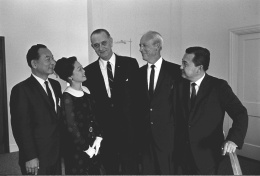 Media
Media
